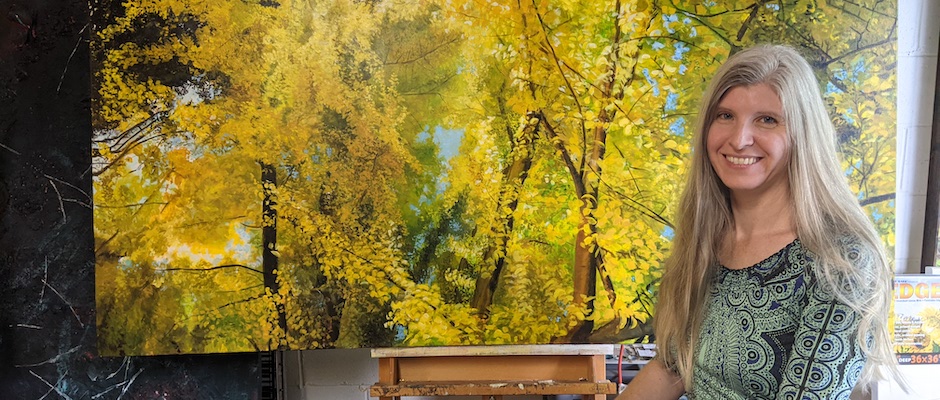
I was 22 when the pain started that was not associated with my period. Even though my periods were always painful and heavy, this was a persistent pain on the left side of my abdomen. I got an ultrasound, and the nurse said that I had two, tiny ovarian cysts that they couldn't really do anything about. So, as I was raised to do, I ignored the pain. However, the pain got worse. Then the back pain started. It was painful to have sex. My periods were debilitating. I remember my college roomate said that she'd never seen someone be so incapacitated by a period. This was normal for me. I saw it happen to my mother and my sister, so I assumed this is how it was. Pain is a part of life, and you just push through it.
One thing that helped me manage the pain was to focus on painting and drawing. The world would melt away. I could focus on the lines, the colors, and the subject so deeply that I could block out the pain. I got so good at it I made it my profession. I became a scenic artist right after college. I excelled at painting large theatrical backdrops in days, and working really long hours doing something that I loved. But once I finished the day, I was a wreck. The pain would flood back. I started going to a chiropractor for my knee and back pain. It didn't really help. I still had debilitating periods, but I would just take a Naproxen and move on. I really knew nothing about a life without pain. It was daily, and unfortunately, still is.
I never thought I had endometriosis because I had two healthy babies with no complications. I would go to doctors about my gastro symptoms, my chest pain, my numbness, mood swings, and joint inflammation, and they couldn't find anything wrong. They would suggest changing my diet, quit smoking or drinking, or try yoga. I quit smoking a long time ago, I barely drink, and I already did yoga. I would be dismissed by doctors about my symptoms so many times, I just stopped going and suffered in silence. This went on for 18 years.
It wasn't until I finally found a great OBGYN who actually listened to me and found out I had an ovarian cyst that was roughly two and a half inches in diameter, that hope started to creep in. However, the real event that revealed my diagnosis occurred when I had to go to the emergency room because I had lost a pint of blood in one hour. I thought my cyst had burst. My OBGYN immediately contacted me, and told me I was eligible for a hysterectomy. I had bled to anemia twice, and that is what made me eligible. I didn't have any reservations about doing it. I already had my two beautiful boys, was in my early forties, and was not interested in having more children.
My OBGYN came back after the hysterectomy and told me that not only did they remove the ovary with the cyst on it, they also found I had endometriosis, as well as adenomyosis in my uterus and around my ovaries. Finally an answer! I cried, and I thanked her for finally giving me a name to what caused me suffering.
I immediately started doing research and found the Endometriosis Foundation of America website. All the information I read started making sense and explained what was going on with me! For over two decades I was always asking myself, "What is wrong with me?" Having answers validated what I was feeling for all those years. All the supposedly unrelated symptoms I was experiencing finally had a connection.
I developed a gluten allergy, even though food allergy tests never quite confirmed it. I eliminated gluten from my diet, and a lot of my symptoms subsided. I read that gluten can be a trigger for inflammation in women with endometriosis. *DING*, another connection. My back pain was chalked up to "occupational hazard," but women with endometriosis have back pain and joint inflammation. Another *DING*. Women have gastro-intestinal issues with endometriosis. *DING*. I've had two colonoscopies and barium enema to find out what is wrong with my intestine, and the gastroenterologist couldn't find anything. It really is the invisible disease. It makes it harder to convince people that you're not okay.
A total of six months after the hysterectomy, I finally lived a life without chronic pain. It was like a new me! Sex wasn't painful, and I could use my full brain instead of half of it to block out the pain. I finally felt like a complete person forthe first time in my life.
But after six months the symptoms started creeping back. It started with pain in my abdomen, then back pain, then knee swelling, pain in my chest, nerve pain, etc. These days I have good days and bad days, and I'm just accepting that this is my life. I will go on for long stretches of good days where I can manage the pain, but there are days I just cannot function. Maybe because I'm older I've learned to not push through it. I allow my body to rest when it needs to, and get the exercise and care it needs when I'm able. It's taken my husband two decades to understand and empathize with me, but I know he's there to help me when I can't do anything. My children have also been a support in my life. I'm just glad I'm not alone in this fight. My hope is to raise more awareness so people like me won't suffer in silence like I did for so many years.
Sabra L Crockett is a full time artist with experience working in scenic art, decorative painting, and realism painting for over 20 years. When she's not painting she's out in the forest or fields searching for her next subjects, or she's out exploring with her husband and two sons. However, she rather just lounge around with her two cats.
Editor's note: Would you like to contribute to EndoStories? Click here to learn how to submit your work.
*Patient stories submitted to EndoFound.org are the views of the patient and not necessarily those of the foundation. All testimonials are from real patients, and may not reflect the typical patient’s experience, and are not intended to represent or guarantee that anyone will achieve the same or similar results.









